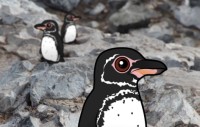Birdorable Chestnut-sided Warbler

The Chestnut-sided Warbler is a small songbird with a yellow forehead, white breast and chestnut streaks along its sides. They bread in eastern North America and winter in Central America. Each winter they return to the same area where they'll forage with the same flock of resident tropical warblers. What a great way to catch up with old friends! So many birds are decreasing in number these days due to habitat destruction, but this little fellow is actually doing very well. It increased tremendously in the late 19th century as second growth forests became more common.

This is our cute Birdorable version of the Chestnut-sided Warbler, bringing the total number of Birdorable warblers to four. We live in Northern Illinois and most warblers are expected to arrive here through May. Warblers are notoriously difficult to identify because there are so many that look so much alike, and they don't stay still for too long. What's your favorite warbler species?






Comments
Leave a comment
Thank you!